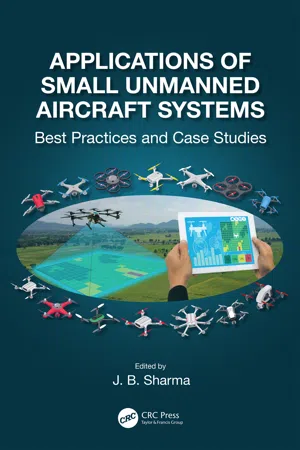
Applications of Small Unmanned Aircraft Systems
Best Practices and Case Studies
- 290 pages
- English
- ePUB (mobile friendly)
- Available on iOS & Android
Applications of Small Unmanned Aircraft Systems
Best Practices and Case Studies
About This Book
Advances in high spatial resolution mapping capabilities and the new rules established by the Federal Aviation Administration in the United States for the operation of Small Unmanned Aircraft Systems (sUAS) have provided new opportunities to acquire aerial data at a lower cost and more safely versus other methods. A similar opening of the skies for sUAS applications is being allowed in countries across the world. Also, sUAS can access hazardous or inaccessible areas during disaster events and provide rapid response when needed. Applications of Small Unmanned Aircraft systems: Best Practices and Case Studies is the first book that brings together the best practices of sUAS applied to a broad range of issues in high spatial resolution mapping projects. Very few sUAS pilots have the knowledge of how the collected imagery is processed into value added mapping products that have commercial and/or academic import. Since the field of sUAS applications is just a few years old, this book covers the need for a compendium of case studies to guide the planning, data collection, and most importantly data processing and map error issues, with the range of sensors available to the user community.
Written by experienced academics and professionals, this book serves as a guide on how to formulate sUAS based projects, from choice of a sUAS, flight planning for a particular application, sensors and data acquisition, data processing software, mapping software and use of the high spatial resolution maps produced for particular types of geospatial modeling.
Features:
-
- Focus on sUAS based data acquisition and processing into map products
- Broad range of case studies by highly experienced academics
- Practical guidance on sUAS hardware, sensors, and software utilized
- Compilation of workflow insights from expert professors and professionals
- Relevant to academia, government, and industry
- Positional and thematic map accuracy, UAS curriculum development and workflow replicability issues
This book would be an excellent text for upper-level undergraduate to graduate level sUAS mapping application courses. It is also invaluable as a reference for educators designing sUAS based curriculum as well as for potential sUAS users to assess the scope of mapping projects that can be done with this technology.
Frequently asked questions
1
sUAS Data Accuracy in Photogrammetric Workflows
Qassim Abdullah and Riadh Munjy
CONTENTS
1.1 Source of Errors in UAS Photogrammetry
1.1.1 Datum and Coordinate Systems
1.1.2 Flight Planning and Execution
- Flight Pattern: Flight patterns are optimized for minimizing flight time, wind direction, and topography (Anders et al. 2013). Windy conditions consume more battery energy than calm conditions. Flight patterns can be vertical, oblique, or circular (Chiabrando et al. 2017). Flights in opposite directions can contribute to a better estimation of the principal point when self-calibration is applied in the block adjustment (Gerke and Przybilla 2016). It is advisable to add extra frames at the end of each flight line since poor image quality results during turn-about (Zajkowski and Snyder 2016).
- Imagery Overlap: Certain imagery overlap is required to achieve accurate and reliable products. To take advantage of using Structure from Motion (SfM) algorithms, the forward overlap must be increased. Forward overlap of 80% and side overlap of 60% to 70% provide better accuracy and reduce image mismatches (Nasrullah 2016).
- Flying Altitude: The imagery product’s positional accuracy is influenced by the accuracy of the sensor orientation determination during the aerial triangulation process. Accordingly, the accuracy of the geospatial products decreases as the flying height increases assuming the same camera and lens were used during these flights. Lowering the flight altitude demands a longer acquisition time and may increase building lean effect (Nasrullah 2016). Adding images with different altitudes (20% higher) may improve the block accuracy (Yanagi 2016; Hoffman et al. 2016), which will contribute to better focal length estimation when self-calibration is being used.
- Corridor mapping: For corridor mapping, the accuracy depends on the number and distributi...
Table of contents
- Cover
- Half-Title
- Title
- Copyright
- Dedication
- Contents
- Foreword
- Preface
- Acknowledgements
- Editor
- Contributor List
- 1 sUAS Data Accuracy in Photogrammetric Workflows
- 2 Unmanned Aerial Systems (UAS) and Thematic Map Accuracy Assessment
- 3 Multiuser Concepts and Workflow Replicability in sUAS Applications
- 4 The sUAS Educational Frontier: Mapping an Educational Pathway for the Future Workforce
- 5 Federal Government Applications of UAS Technology
- 6 sUAS for Wildlife Conservation – Assessing Habitat Quality of the Endangered Black-Footed Ferret
- 7 Multi-View, Deep Learning, and Contextual Analysis: Promising Approaches for sUAS Land Cover Classification
- 8 UAS for Nature Conservation – Monitoring Invasive Species
- 9 Small Unmanned Aerial Systems (sUAS) and Structure from Motion for Identifying, Documenting, and Monitoring Cultural and Natural Resources
- 10 New Insights Offered by UAS for River Monitoring
- 11 The Campus as a High Spatial Resolution Mapping Laboratory – Small Unmanned Aerial Systems (sUAS) Data Acquisition, Analytics, and Educational Issues
- 12 Flying UAVs in Constrained Environments: Best Practices for Flying within Complex Forest Canopies
- Index